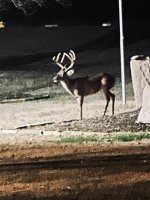
Oh Deer!
Both urban and rural landscapes face challenges from the local wildlife
With the ever-increasing expansion of America’s suburban development reducing the natural habitat of our wildlife, we are seeing an increase of this wildlife venturing into our neighborhoods. They are here for the food. These plants should be a feast for the eyes, not for the deer.
This is especially true during heatwave/drought conditions where natural food sources dwindle down to nothing. In desperation, they will venture to places they normally would not in order to feed.
Our rural homeowners are all too familiar with this issue. Our suburban folks are learning how to live with it.

Several years ago we installed a landscape in Austin which included a ground cover named “Mountain Pea.” The customer’s neice had just graduated with a degree in landscape design and this was a plant she included in a design she did for them. We followed and created the designed landscape.
As you may know, there are a large number of deer who live in the neighborhoods of Austin. The urban environment offers them some protection from predators and ample food sources. Residents certainly aren’t a threat to them. They get treated like pets.
Once we installed the plants and planted the 120 Mountain Pea the design called for, we headed out. Before I could get to the hotel room, I received a call from the customer, saying that the deer moved in right after we left and ate every one of those Mountain Pea. All of them. Chewed them to the ground.
We then found a way to replace the Mountain Pea with a ground cover that tolerates shade and that the deer won’t eat. That led us to “Horse Herb,” a plant that deer leave alone. You cannot get rid of the deer, so go with plants they do not like to deter them from your landscape.
During the late 1990s, a Dallas suburb conducted a coyote extraction program. This lasted a couple of years. They would trap or capture the coyotes and relocate them to rural settings. This was done after complaints from residents who feared for their kids and pets’ lives.

The program worked as it was designed to, a huge success. However, the absence of ethis predator allowed the rabbit population to explode. Folks were having their landscapes grazed on by the rabbits. They love our seasonal flowers and even some perennial flowers. When those items are gone, they move on to shrubs like dwarf Nandinas. Most homeowners aren’t aware of what is happening. In most cases, they just see their stuff disappearing.
But there are ways to deal with this unique problem.
One of the ways we can deter deer and rabbits from our landscapes is by planting plants and flowers that they do not like and want to avoid. Also, highly fragrant plants will discourage them from coming around.
The following list is of plants we grow in Texas that deer do not like or want to be around.
1. Society Garlic
2. Marigolds
3. Verbena
4. Floss Flower
5. Snapdragons
6. Butterfly Bush
7. Cinquefoil
8. Spirea
9. Russian Sage
10. Bee Balm
11. Peony
12. Dusty Miller
13. Lambs Ear
Include any of many of these plant varieties in your landscape and your deer and rabbit damage will likely be greatly reduced.
Products you can use
There are products on the market that can be used to help keep the varmints away as well. These include Coyote Urine, Fox Urine which are sold in a granular form and often come in salt shaker-like container/dispensers.
Fox and Coyote Urine deters them because the rabbits and deer smell “predator.” So naturally, they will try to avoid these areas.
These products have to be reapplied after any rain event and also after spinkler cycles. Humans cannot smell these products, but the wildlife will.
There are other products, such as Rabbit Scram! and also Deer Scram! which are also fairly effective to use. Both products will last longer and can be reapplied less frequently.
The To Do list for February
1. Apply pre-emergent to your lawns and beds this month. Do not apply this product to a bed which have flowers that reproduce by seed.
2. Check over all lawn care equipment, replacing spark plugs, oil and filters. Sharpen blades, You will be using this equipment in March.
3. Trim your Crape Myrtles this month. Trim them as you would any other tree. Do not hack them short.
4. Trim back all ornamental grasses. You will want to trim these way back, close to the base. You can cut straight across or give it a rounded effect.
5. For you gardeners, make sure you get your potatoes planted by Valentines Day!





